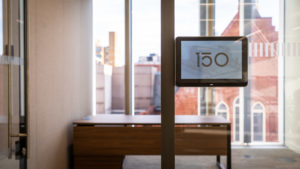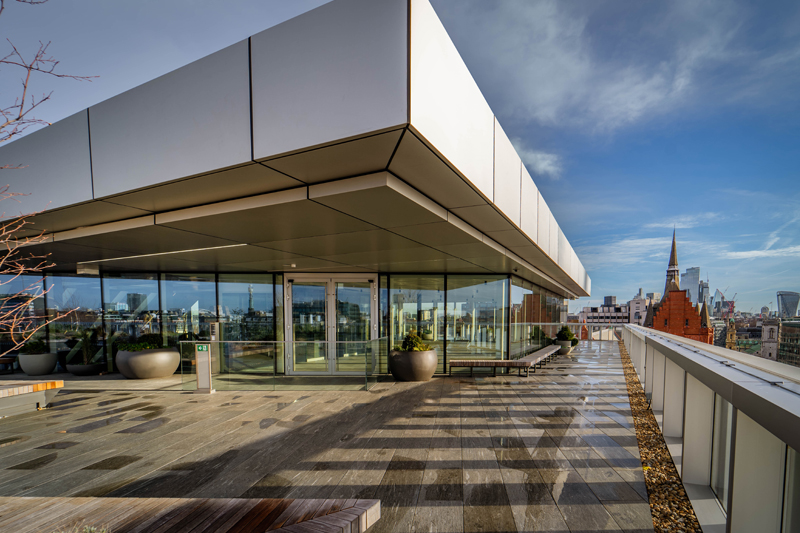Kas Mohammed, VP Digital Energy UK&I at Schneider Electric, explores the variety of smart technology enabling buildings to become more efficient
By 2030, the continued adoption of hydrogen and renewable energy sources, as well as advancements in energy storage and AI-powered optimisation, will drastically alter the energy environment. The message for building operators is straightforward: change or risk falling behind. The building industry, one of the biggest polluters, is also under strain as a result of the UK’s aggressive Net Zero ambitions. The good news is that a clear path to decarbonisation is provided by smart technologies.
These developments are essential for increasing productivity, maximising energy use and reducing waste. When spaces are empty, simple yet effective solutions like occupant based smart controls automatically switch the lighting, HVAC and plug loads to energy-saving modes. On days with low occupancy, even these minor changes can make a big impact, cutting operating expenses by up to 22%. Optimising the use of electricity is not only advantageous but also necessary, as it currently accounts for 34% of all final energy consumption in buildings.
Sustainable buildings: the key to a low carbon tomorrow
To meet the UK’s ambitious Net Zero emissions target ahead of 2050, decisive action will be required by the construction industry. Fortunately, smart technologies are already being used by progressive operators, setting the stage for a more sustainable future. It’s perhaps no surprise when you consider the economic opportunity offered by the green building market in the UK. It’s expected to expand at a compound annual growth rate (CAGR) of 11.10%, from £6.6 billion in 2024 to £17.1 billion by 2033. Adding to this, stricter government rules and regulations are only set to propel sustainable construction, driving up demand for technologies that monitor and manage energy efficiency in buildings. Sustainable construction will become even more vital as urban populations continue to increase, necessitating future-proof developments.
Building owners need to improve the visibility of their operations in order to meet this shift. Significant reductions are hard to achieve without a thorough understanding of where energy is being utilised, consumed and wasted. Since the climate problem is fundamentally an energy one, smart technologies are crucial to provide the insights required to promote increased efficiency.
Fortunately, it’s now easier than ever to retrofit smart technologies into existing structures. For example, installing inexpensive IoT sensors throughout a building allows for the collection of real-time data on temperature, occupancy, energy use and air quality. This information gives operators the ability to optimise energy use, make well informed decisions and improve maintenance effectiveness when combined with a central software management system. As a result, operators can optimise space utilisation, lower personnel requirements and enhance cost control by employing real-time insights. Imagine a typical building with temperature fluctuations. By monitoring the dispersion of heat, operators can discover if a particular room lacks adequate insulation. To create an efficient thermal barrier, operators can install high quality, sustainable insulation right away rather than depending on hunches or costly assessments.
The development of smart technologies will make buildings more flexible. Microgrids, wind turbines and rooftop solar panels will blend seamlessly with the current infrastructure, reducing reliance on outside energy sources. Routine servicing will give way to predictive, on-demand interventions in maintenance, which will save costs and increase operational effectiveness. In the end, the shift to smart buildings is an essential first step in the direction of a sustainable future.

Optimising operations through smart technologies
Smart technologies have an impact that goes beyond just how buildings are operated. AI is transforming the planning, building and maintenance of structures from the design stage to on-site personnel management. These technologies improve sustainability and cut waste by enabling architects to produce digital models prior to the start of construction, which can be used to simulate energy saving measures.
By simulating different situations, these virtual duplicates allow operators to test energy saving techniques before putting them into practice in the real world. One noteworthy example is from The University of Liverpool, where HVAC renovation plans were evaluated using digital twin technology. The result was that one campus building’s energy usage was reduced by 23%, saving £25,000 in operating expenses annually.
Smart technologies continuously improve a building’s performance after it is up and running. Sensors keep an eye on important variables like illumination, temperature and air quality, and they automatically modify systems in accordance with pre-set criteria. Machine learning algorithms examine this data over time looking for trends to improve system performance. With little human labour, operators can get maximum energy efficiency thanks to this continuous improvement process. Building owners can concentrate on other aspects that promote sustainability and long-term asset value as automation increases and energy waste declines.
The production of materials is also changing due to AI-driven efficiencies. Digital procurement in the construction industry is streamlining supply chains and guaranteeing more efficient use of resources. Simultaneously, improvements in automated quality control are improving sustainability. For example, concrete slabs are now inspected for flaws prior to installation, which drastically cuts down on material waste.
Shaping the future with technology
Data is the key to increasing efficiency for building operators. With time, sophisticated AI and machine learning systems improve their accuracy by regularly analysing past data. The benefits are extensive with predictive maintenance extending the life of HVAC, escalators and lifts. Buildings adjust to user preferences, improving occupant comfort while optimised environmental conditions boost workplace productivity. For facilities managers, the design and maintenance of electrical systems is also changing. Before power infrastructure is physically implemented, engineers can use digital twins to model it virtually, reducing inefficiencies and design errors.
Furthermore, the ‘live digital twin’ idea guarantees that real-time operational data is constantly added to a facility’s virtual model. Facility managers can accurately plan future renovations, such as adding EV charging stations or increasing power capacity to meet rising demand, thanks to this continuous optimisation.
There isn’t a single, universal strategy for smart buildings. Connectivity is crucial for success, though, as the more systems that are connected via IoT devices, the more opportunities there are to increase efficiency. Operators can future proof their assets without making significant upfront investments by working their way up from basic monitoring to completely autonomous building management.
Charting the course to Net Zero
Many building operators in the UK are already demonstrating the capabilities of smart technologies. At its UK headquarters in 150 Holborn, for instance, the worldwide design, engineering and construction company Sidara is setting a new standard. Here, more than 60,000 data points are collected and processed by more than 650 IoT devices.
By monitoring environmental factors, occupancy trends and energy use, these smart building technologies enable real-time alterations to heating and cooling, driving up efficiency. This data-driven strategy has resulted in a 22% decrease in carbon emissions and energy use during low-occupancy periods. By continuously monitoring CO₂ levels, humidity and volatile organic compounds (VOCs), these smart systems ensure that indoor air quality remains within acceptable bounds.
Looking ahead, smart buildings are set to have a significant influence on commercial real estate, playing a vital role in reducing the built environment’s carbon footprint as the race to Net Zero continues. By leveraging cutting-edge technologies, from digital twins to machine learning and automation, building operators can ensure they are well equipped to realise a more robust and resilient built environment in the years to come.
Further details can be found here
Find more industry feature articles here





